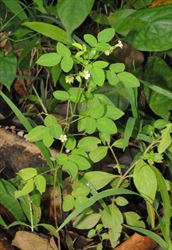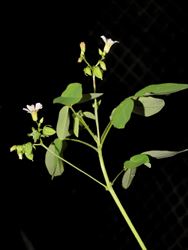Barrelier's woodsorrel. It is also known as French trèfle, lavender sorrel.
Pacific Pests, Pathogens, Weeds & Pesticides - Online edition
Pacific Pests, Pathogens, Weeds & Pesticides
Barrelier's woodsorrel (515)
Oxalis barrelieri; previously, it was known as Oxalis bahiensis. It is a member of the Oxalidaceae.
Asia, Africa, North (Mexico), South and Central America, the Caribbean, Oceania. It is recorded from Australia, American Samoa, Federated States of Micronesia, Fiji, French Polynesia, Palau, and Samoa. It is said to be native to the Caribbean, and Central and South America. (Kew says it is "tropical America").
An occasional, perennial weed, in some Pacific island countries. It is found in forest clearings, and on disturbed soils e.g., along roadsides. The woodsorrel favours well-drained, light sandy and medium loamy soils, and tolerates light shade. A weed of coconut and sugarcane plantations, pastures and other cultivated areas. Found from 900 to 1220 masl.
Stems 20-150 cm, densely hairy at the base, and often woody. Leaves, alternate along the stems, with leaf stalks about 50 mm long, bearing three leaflets, each on short stalks up to 10 mm long (central leaf longest), oval to spear-shape, with the central leaflet larger than the others, up to 55 mm long and 30 mm wide (Photos 1&2). All leaflets hairy underneath. Inflorescence (collection of flowers), from leaf axils, 4-7 cm long, often dividing into two, with branches up to 3 cm, bearing tubular flowers, with five, white, pink or purplish petals, 7-8 mm long, with bright greenish-yellow centres (Photos 3&4). Fruits are ovoid (egg-shaped), blunt at each end, about 10 mm long and 5 mm wide (Photo 5). When dry, the fruits split open to release tiny seeds.
Seed; spread may occur in water, by ants, and accidently by people. The weed has an attractive flower and seeds may be taken to be grown as an ornamental.
Occasionally, weedy in Northern Mariana Islands and Samoa. In Samoa, it has been reported as a common weed in taro gardens. By contrast, Smith in his Flora vitiensis nova says it is "an infrequent weed of roadsides and cultivated areas", in Fiji.
Leaves are eaten; they contain oxalic acid giving them a sharp flavour, which is reduced if leaves are cooked. People with a tendency towards rheumatism, arthritis, gout or kidney stones are advised to show caution before taking this plant as a food. Used medicinally for diarrhoea.
BIOSECURITY
Oxalis barrelieri is not widely distributed, especially in Pacific island countries. Consequently, those countries not yet infested should consider all likely pathways for entry, and apply quarantine measures accordingly. Particular attention should be given to the use of the plant in traditional medicines, as an ornamental, and the fact that seed could be sent with relative ease across international borders.
BIOCONTROL
No information of successful management.
CULTURAL CONTROL
- Physical & Mechanical:
- Hand weeding is effective on small areas where follow-up is possible to control seedlings. Best to begin when plants are young, before seed production.
- Slashing is effective in order to encourage less-invasive species. It will need to be done regularly.
- Mulching:
- Maintain a layer of mulch. The seeds are small and seedlings will have difficulty penetrating a 5-10 cm layer of mulch. Use woodchips, grass clippings, etc.
- Hygiene:
- Treat vehicles and farm machinery. If moving from areas where the weed occurs to those weed-free, wash to remove soil and seed. This is equally important if the machinery is being imported into a country or moved within a country.
CHEMICAL
In Fiji, a number of recommendations have been made, including: glyphosate, 2,4-D, dicamba, MCPA.
--------------------
Note, EU approval to use glyphosate ends in December 2022; its use after that date is under discussion.
____________________
When using a pesticide, always wear protective clothing and follow the instructions on the product label, such as dosage, timing of application, and pre-harvest interval. Recommendations will vary with the crop and system of cultivation. Expert advice on the most appropriate herbicides to use should always be sought from local agricultural authorities.
AUTHORS Grahame Jackson & Makereta Ranadi
Information from Oxalis barrelieri L. Plants of the world online. Royal Botanic Gardens, Kew. (https://powo.science.kew.org/taxon/urn:lsid:ipni.org:names:177777-2); and Oxalis barrelieri L., Oxalidaceae. Pacific island ecosystems at risk (PIER). (http://www.hear.org/pier/species/oxalis_barrelieri.htm); and Fern K (2021) Oxalis barrelieri L. Oxalidaceae. Tropical Plants Database. (http://tropical.theferns.info/viewtropical.php?id=Oxalis+barrelieri); and from Smith A (1981) Flora Vitiensis Nova: A new flora of Fiji. 2nd ed. Fiji: Lawai, Kauai, Hawaii. National Tropical Botanical Garden. Photo 2 Aris riyanto (2020). (https://commons.wikimedia.org/wiki/File:Oxalis_barrelieri_-_Calincing_tanah_-_Lengkongwetan_2020_3_cropped_hdr.jpg). Photo 3 O.M. Montiel (2021) TROPICOS.(http://www.tropicos.org/Image/100105471). Photos 1,4&5 Christian Moliné (2012) Oxalis barrelieri - Mataso (Fiji). (https://powo.science.kew.org/taxon/urn:lsid:ipni.org:names:177777-2).
Produced with support from the Australian Centre for International Agricultural Research under project HORT/2016/185: Responding to emerging pest and disease threats to horticulture in the Pacific islands, implemented by the University of Queensland, in association with the Pacific Community and Koronivia Research Station, Ministry of Agriculture, Fiji.








